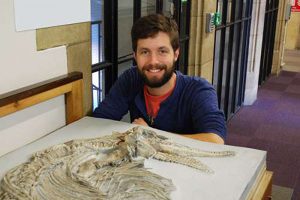
Credit: University of Bristol
A new species of British ichthyosaur has been identified using skeletal remains that have been on display at the University of Bristol’s School of Earth Sciences for many years.
Ichthyosaurs lived during the age of the dinosaurs but were ocean dwelling reptiles that resembled dolphins or sharks.
They were fierce predators, some growing up to 15 metres long.
The newly identified species lived around 200 million years ago in the early Jurassic period, a time when the UK was a small series of islands.
The six year study, led by the University of Manchester, and published today in Papers in Palaeontology, set out to search for British examples of ichthyosaurs and researchers were able to identify features in the skull and fins of fossilised remains that distinguished the new species from others.
The research was carried out by Dean Lomax (Honorary Scientist at The University of Manchester) and Professor Judy Massare (Brockport College, New York).
Specimen ‘25300’ (the complete skeletal remains of the large ichthyosaurus found in Walton, Somerset) was donated to the University of Bristol around 80 years ago by the City Museum.
It was originally part of the Chaning Pearce collection purchased by the museum in 1915 and donated to the university in 1930.
Joseph Chaning Pearce (1811-1847) was born and lived in Bradford-on-Avon in Wiltshire and during his life built up one of the largest collections of fossils in the country in the early 19th century.
Dean Lomax, Honorary Scientist at the University of Manchester, said: “It’s quite amazing – hundreds of people must walk past this skeleton every day, yet its secrets have only just been uncovered.
“We’ve named the species Ichthyosaurus larkini in honour of the British palaeontologist Nigel Larkin – the name Larkin actually means ‘fierce’ so it’s quite fitting for a fast-moving predator.”
Jonathan Hanson, Collections and Practical Manager from the School of Earth Sciences at the University of Bristol, said: “Ichthyosaurs, with their similarities to both modern fish and dolphins, are among the more arresting and captivating fossil specimens known; we are very lucky to have two such specimens on display in the Wills Memorial Building, as part of the University of Bristol School of Earth Sciences Collection.
“There is no greater honour for a fossil than to be named as a type specimen for a species, and we are very happy to meaningfully contribute to the understanding of the history of life on Earth by supporting the discovery of Ichthyosaurus larkini.”
Reference:
Lomax, D. R. and Massare, J. A. 2016. Two new species of Ichthyosaurus from the lowermost Jurassic (Hettangian) of Somerset, England. Papers in Palaeontology, DOI: 10.1002/spp2.1065
Note: The above post is reprinted from materials provided by University of Bristol.










